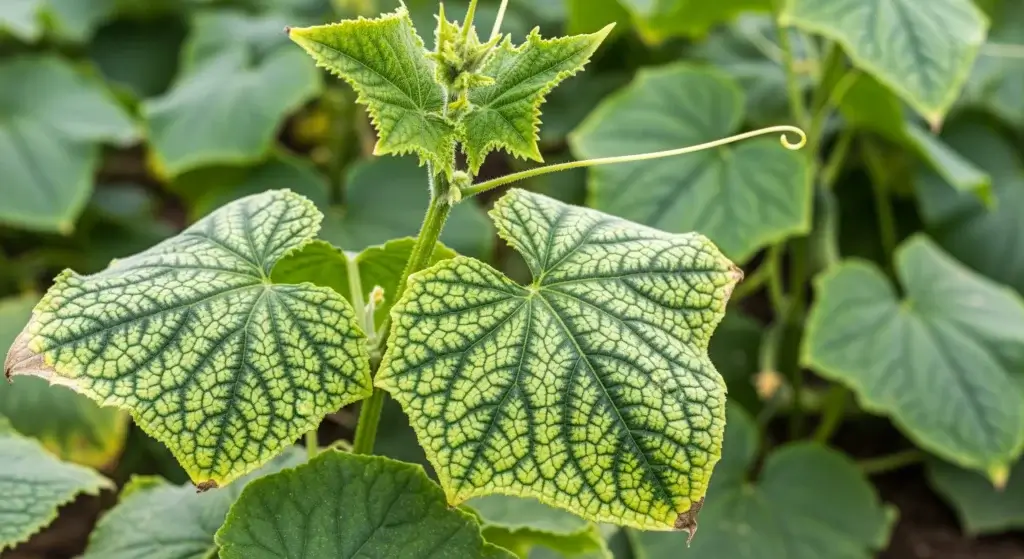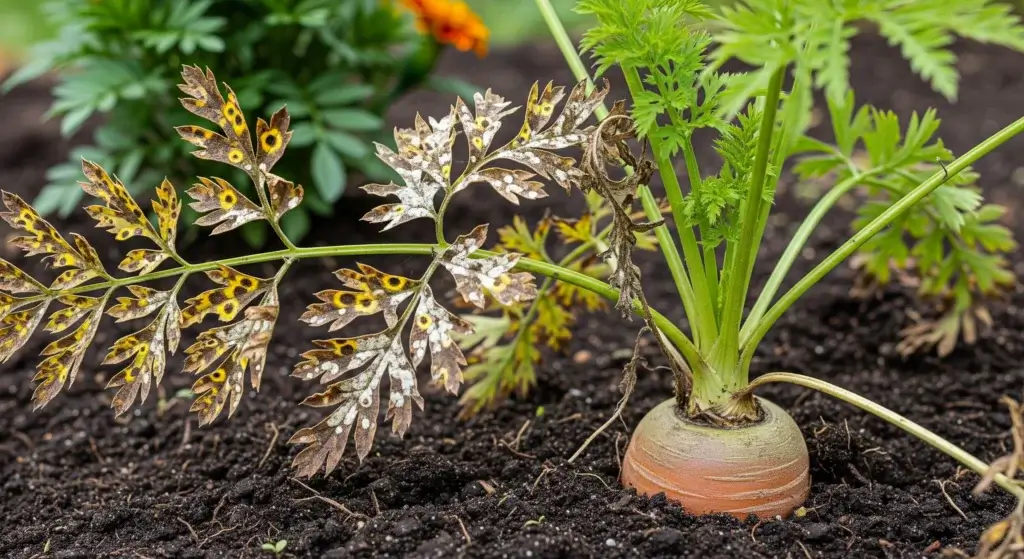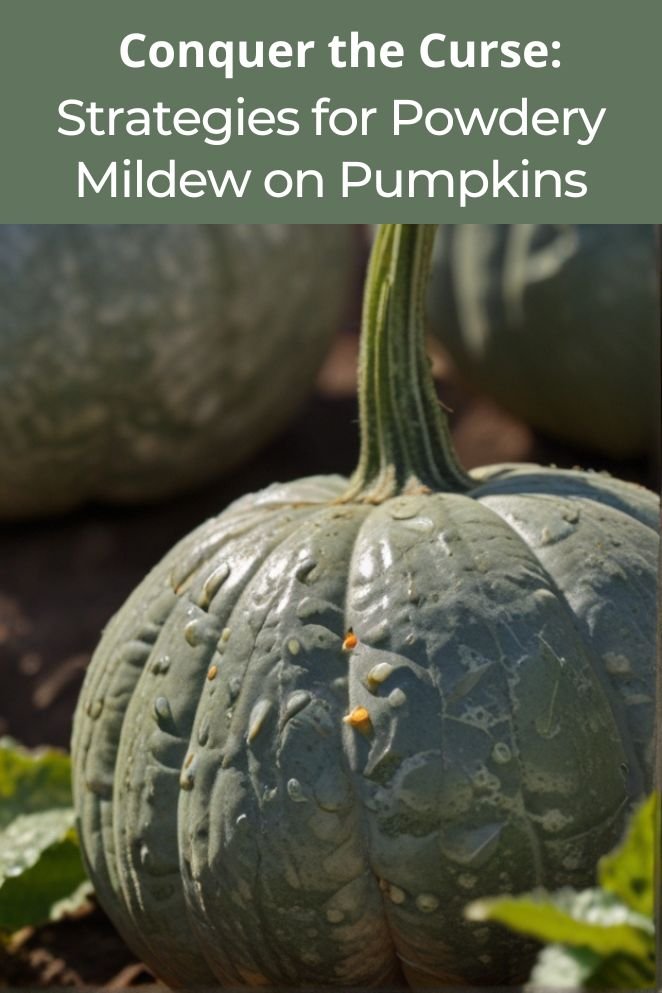
Powdery mildew is a fungal disease that affects plants by covering them in a white, powdery substance.
It’s caused by the fungus Erysiphe cichoracearum and is most commonly found on plants with high humidity and temperatures between 65°F and 75°F (18°C and 24°C).
Pumpkins are particularly susceptible to powdery mildew, especially during the fruiting stage.
Signs of Powdery Mildew on Pumpkins
The signs of powdery mildew on pumpkins are easy to spot.
The fungus causes a white, powdery substance to form on the leaves and stems of the plant.
This substance is actually the spores of the fungus, which are released into the air to spread the disease.
Other signs of powdery mildew include:
- Yellowing or browning of leaves: Infected leaves may start to yellow or brown, particularly around the areas where the powdery substance is present.
- Reduced plant growth: As the fungus takes hold and spreads, it can stunt the growth of the pumpkin plant.
- Reduced fruit production: Infected plants may produce fewer fruits, and those that do develop might be smaller or misshapen.
- Premature fruit drop: In severe cases of powdery mildew infection, the affected pumpkin plant may experience premature fruit drop.
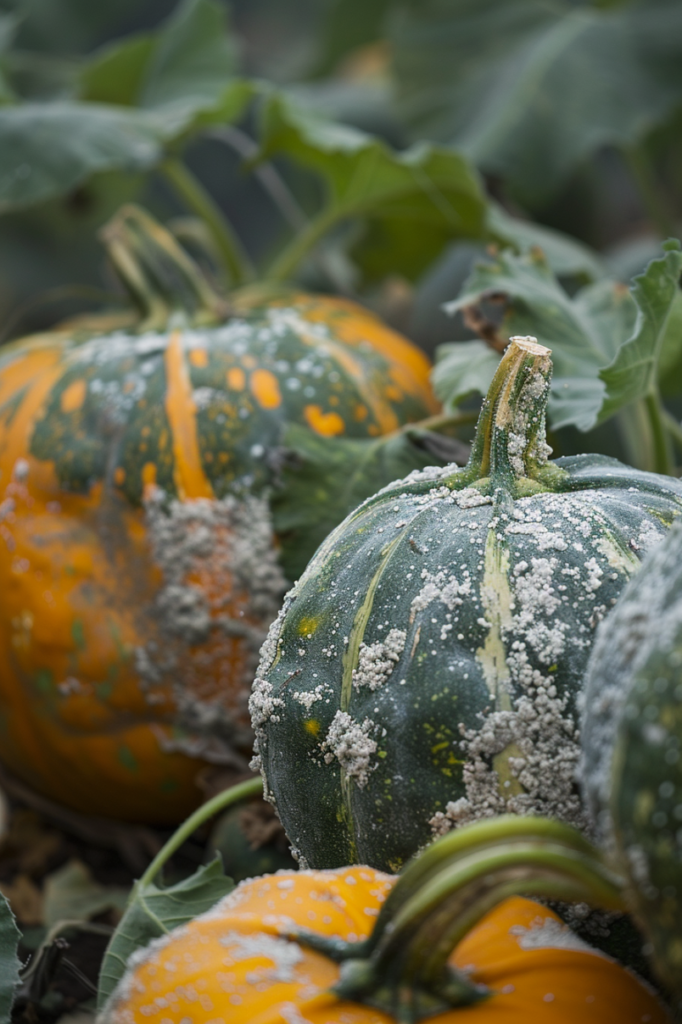
Key Differences Between Powdery Mildew And Downy Mildew
| Aspect | Powdery Mildew | Downy Mildew |
| Appearance | White, powdery substance on leaves and stems |
Fuzzy, grayish patches on the underside of leaves
|
| Spore Dispersal | Spores spread through air |
Spores spread through water and air
|
| Temperature | Thrives in warm, dry conditions |
Prefers cooler, moist environments
|
| Leaf Affection | Typically affects upper leaf surfaces |
Affects lower leaf surfaces
|
| Favored Hosts | Common on cucurbits (e.g., pumpkins, cucumbers) |
Affects a wide range of plants
|
| Disease Progression | Develops gradually over time |
Can spread rapidly, causing rapid plant decline
|
| Management | Cultural practices, fungicides, pruning |
Fungicides, resistant varieties, cultural practices
|
- Read also: The Pesticide Paradox: The Impact of Pesticides on Vegetable
- Read also: Pest Damage on Vegetables: A Guide to Identification and Control
The Impact of Powdery Mildew
Powdery mildew isn’t just a nuisance for pumpkin growers—it can have a significant impact on both yields and the overall quality of the crop.
Here’s a closer look at how this fungal disease affects pumpkins:
Reduced fruit production
One of the most noticeable effects of powdery mildew is a decrease in pumpkin yields.
As the disease takes hold, infected plants may produce fewer pumpkins than healthy ones.
This reduction in fruit production not only diminishes the potential harvest but also translates to economic losses for growers.
Reduced fruit size
Beyond quantity, powdery mildew can also impact the quality of pumpkins.
Infected fruits may grow smaller than usual, compromising their size and marketability.
Smaller pumpkins may not meet the desired standards for consumers or commercial buyers, resulting in lower returns for growers.
Reduced plant growth
Powdery mildew doesn’t just affect the pumpkins themselves—it can also stunt the overall growth of the plant.
As the fungus spreads across leaves and stems, it impedes the plant’s ability to photosynthesize and absorb nutrients.
This can lead to stunted growth, making it harder to manage the disease and potentially exacerbating its impact on yield and quality.
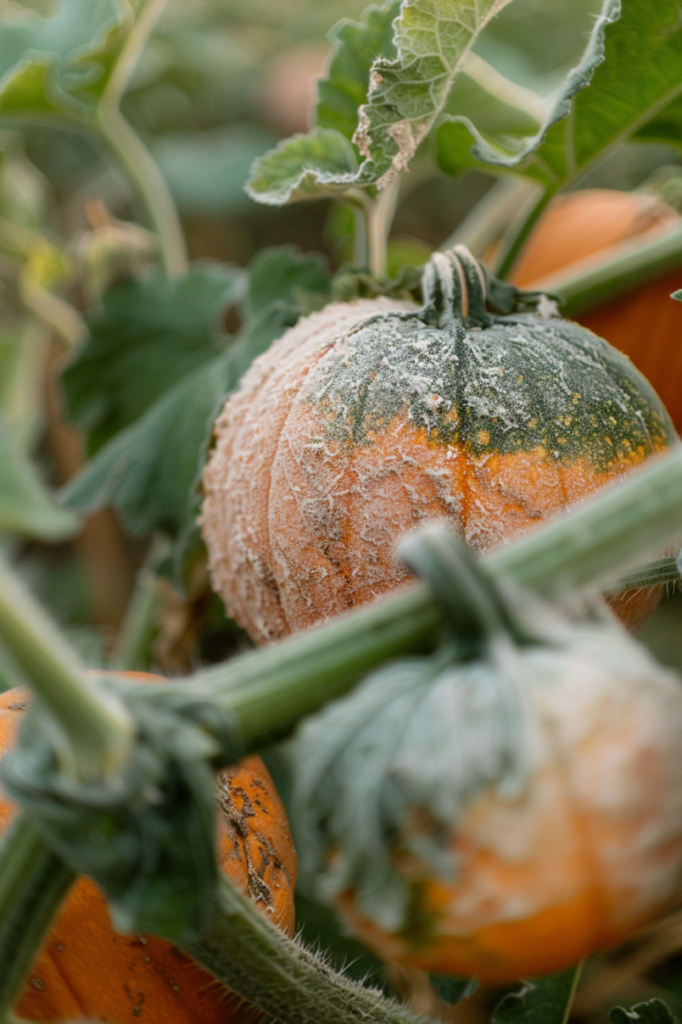
The Causes of Powdery Mildew on Pumpkins
Understanding the underlying causes of powdery mildew on pumpkins is essential for effective disease management.
Here’s a deeper dive into the factors contributing to its development:
High Humidity
Powdery mildew thrives in environments with elevated humidity levels.
Excess moisture in the air provides ideal conditions for the fungus to proliferate and spread rapidly.
Regions experiencing high rainfall or frequent irrigation are particularly susceptible to powdery mildew outbreaks, as the moisture encourages fungal growth on pumpkin leaves and stems.
Warm temperatures
While humidity sets the stage for powdery mildew, temperature also plays a crucial role in its development.
The fungus favors warm temperatures ranging from 65°F to 75°F (18°C to 24°C) for optimal growth.
These moderate temperatures create a conducive environment for the fungal spores to germinate and colonize pumpkin plants, accelerating the spread of the disease during the growing season.
Poor air circulation
Inadequate air circulation exacerbates the spread of powdery mildew.
Areas with dense plantings or limited airflow, such as crowded pumpkin patches or gardens bordered by structures, are prone to increased humidity and reduced ventilation.
Without sufficient airflow to dissipate moisture and disperse fungal spores, powdery mildew can flourish, spreading rapidly among neighboring plants.
Inadequate pruning
Proper pruning practices are essential for minimizing the risk of powdery mildew infection.
Overgrown foliage creates a dense canopy that traps humidity and restricts airflow, creating an ideal breeding ground for fungal pathogens.
Regular pruning helps maintain optimal plant spacing, allowing for better air circulation and reducing the likelihood of powdery mildew outbreaks.
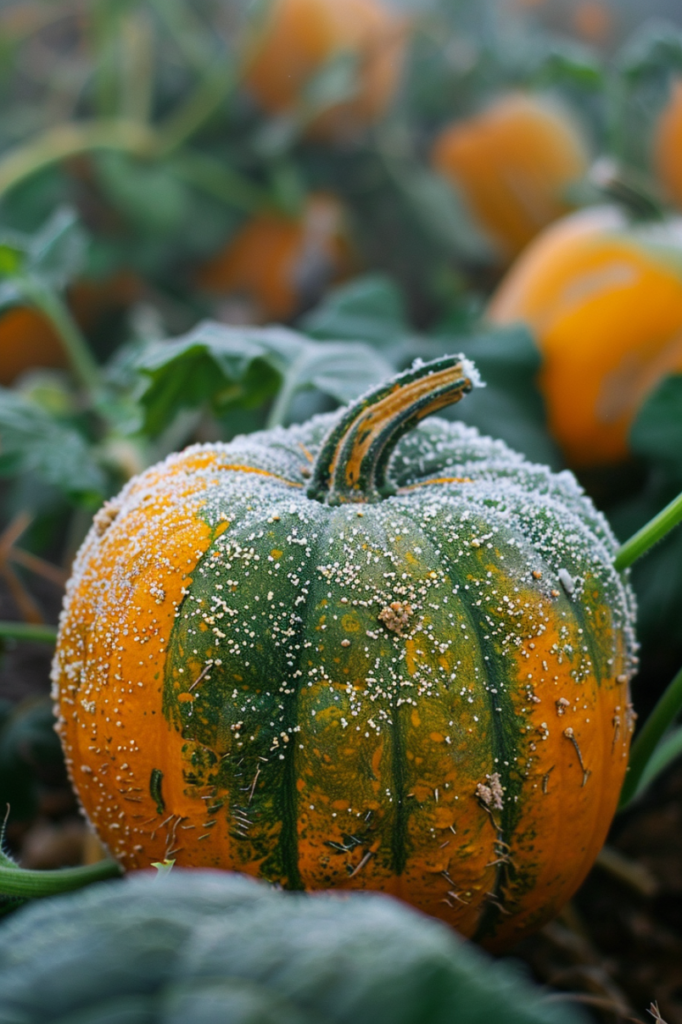
Preventing Powdery Mildew
Preventing powdery mildew is key to maintaining healthy pumpkin plants. Here are some methods you can use:
Natural Methods
Pruning
Regular pruning involves the removal of infected leaves and stems, which helps to contain and minimize the spread of powdery mildew within the pumpkin patch.
By promptly identifying and removing affected plant parts, growers can prevent the disease from spreading to healthy tissues.
Pruning also improves air circulation around the plants, further hindering the development and spread of the fungus.
Air circulation
Adequate air circulation is essential for maintaining a healthy growing environment and reducing the risk of powdery mildew.
By spacing plants appropriately and removing any obstructions that may impede airflow, growers can create an environment that discourages fungal growth.
Improved air circulation helps to dissipate excess moisture on leaves and stems, making it less favorable for powdery mildew to thrive.
Water management
Proper water management is crucial for preventing powdery mildew outbreaks.
Overwatering can create conditions conducive to fungal growth, as excessive moisture on plant surfaces provides an ideal environment for spore germination and proliferation.
By practicing moderation in watering and avoiding overhead irrigation, growers can minimize the risk of powdery mildew while still ensuring adequate hydration for their pumpkin plants.
Crop rotation
Rotating pumpkin crops is a time-honored practice that disrupts the life cycle of powdery mildew and reduces the buildup of fungal spores in the soil.
By planting pumpkins in different locations each season, growers can prevent the disease from establishing a permanent presence in the garden.
Crop rotation also helps to maintain soil health and fertility, contributing to overall crop resilience and productivity.
Fungicides
When faced with a powdery mildew infestation on your pumpkin plants, prompt action is crucial to prevent further spread and mitigate damage.
Let’s delve into the details of some common fungicides used for combating powdery mildew:
Copper-based fungicides
Copper-based fungicides have long been used in agriculture for their broad-spectrum fungicidal properties.
These fungicides work by releasing copper ions, which interfere with fungal cell walls and inhibit their growth.
While effective against powdery mildew, it’s essential to use copper-based fungicides judiciously.
Chlorothalonil
Chlorothalonil is a widely used fungicide known for its efficacy against a broad range of fungal diseases, including powdery mildew.
It works by disrupting fungal cell membranes, thereby preventing their growth and reproduction.
When applying chlorothalonil, it’s essential to follow label instructions carefully to ensure effective control while minimizing environmental impact.
Mancozeb
Another popular fungicide for powdery mildew management is mancozeb.
It belongs to the group of dithiocarbamate fungicides and works by inhibiting key enzymes involved in fungal metabolism.
Mancozeb offers both protective and curative properties, making it a valuable tool for controlling powdery mildew outbreaks.
Thiophanate-methyl
Thiophanate-methyl is a systemic fungicide that penetrates plant tissues, providing long-lasting protection against powdery mildew and other fungal pathogens.
It inhibits fungal cell division and growth, effectively controlling the spread of the disease within the plant.

Additional Tips
Here are some additional tips to help you effectively manage powdery mildew and protect your pumpkin crops:
Regular monitoring
Make it a habit to regularly inspect your pumpkin plants for any signs of powdery mildew.
Early detection is key to preventing the disease from spreading uncontrollably.
Look out for the characteristic white, powdery growth on the leaves and stems.
Utilize resistant varieties
When selecting pumpkin varieties for your garden or farm, opt for those that are known to be resistant to powdery mildew.
Resistant varieties have genetic traits that make them less susceptible to the disease, reducing the likelihood of infection and minimizing the need for intensive disease management efforts.
Modify Irrigation practices
Powdery mildew thrives in humid environments, making overhead irrigation a potential contributing factor to its spread.
Water droplets on the foliage create a conducive setting for fungal growth.
Consider switching to drip irrigation, which delivers water directly to the root zone without wetting the leaves.
- Read also: Protecting Your Brassicas: How to Prevent Cabbage Worms
- Read also: Stress-Free Gardening: Top Tips to Protect Vegetables From Pests
Conclusion
Powdery mildew is a significant problem for pumpkin growers, but it’s not impossible to control.
By understanding the signs, causes, and prevention methods for powdery mildew, you can maintain healthy pumpkin plants and reduce the risk of disease.
Remember to monitor your plants regularly, use resistant varieties, and avoid overhead irrigation to keep your pumpkin plants healthy and powdery mildew-free.

